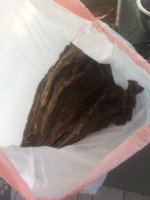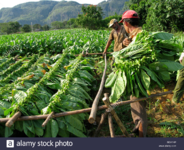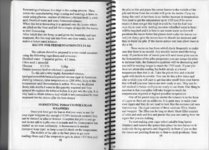PressuredLeaf
Well-Known Member
With my first season of tobacco growing winding down, I'm now getting more involved with the curing process. For my tobaccos I built a small kiln to help with the curing process. This worked beautifully for the sun cured and flu cured tobaccos, but with the very first priming's of cigar tobacco it didn't quite go where I wanted. I noticed all of the kilned tobacco took on a delightful toasty sweet smell, kind of like sweet rolls or something similar. This is great for the pipe varieties, but it's not what I was looking for with the cigar leaf. Something I have read/seen in videos over and over is the pilone fermentation of cigar leaf to release ammonia as a major part of the post harvest processing. I have never noticed ammonia in my kiln. I didn't think much of it because pilones are made from 1000's of pounds of tobacco, and I'm working on a much smaller scale. By chance I noticed something very interesting. I had a pile of 50 or so leaves of yellow twist bud wrapped up in a towel to yellow before hanging (since I'm in a very arid climate), and I had to go out of town for a week. I was very worried the leaves would rot while I was gone, and tossed it up as loss. However, when I came back I noticed something very interesting. The leaves in the center of the pile were very dark with hardly any mold, and there was a strong ammonia odor. I ended up putting these leaves in a trash bag to continue the process, while occasionally airing them out. This ended up being some very tasty tobacco, and it got me thinking if I could replicate the process with cigar leaf.
I had two hands of tobacco yellowing, one of corojo and the other of piloto. Once the leaves were yellow, I hung them up in a closet to dry. After a few days, the leaves were curling, but the midrib was still wet. I then took the leaves and put them in a trash bag to maintain humidity. After about 2 days the smell of ammonia was very apparent, and the bag was moved to the garage which is at about 100f. The ammonia smell is still very strong, even after a few weeks. Surprisingly, there is very little mold - i think the ammonia may be an inhibitor. With these first leaves serving as a proof of concept, I put some more corojo in a separate bag and will be attempting to replicate the process. However, this second bag will be at a lower humidity - closer to medium case. I've already sampled some of the first fermenting leaves, and after drying out they smell "cigar" like- that kind of musty earthy smell. When burned in a small puro, they even tasted like cigars with a harsh edge! My plan is to "sweat" the leaves until the ammonia production goes down, then dry them out and age for a while. I'll update this thread as things progress.


1st bag is new corojo, 2nd is already fermenting corojo and piloto. With the fermenting leaves, you can no longer feel the oil on the leaf ( they are not longer sticky/tacky when you squeeze them).
I had two hands of tobacco yellowing, one of corojo and the other of piloto. Once the leaves were yellow, I hung them up in a closet to dry. After a few days, the leaves were curling, but the midrib was still wet. I then took the leaves and put them in a trash bag to maintain humidity. After about 2 days the smell of ammonia was very apparent, and the bag was moved to the garage which is at about 100f. The ammonia smell is still very strong, even after a few weeks. Surprisingly, there is very little mold - i think the ammonia may be an inhibitor. With these first leaves serving as a proof of concept, I put some more corojo in a separate bag and will be attempting to replicate the process. However, this second bag will be at a lower humidity - closer to medium case. I've already sampled some of the first fermenting leaves, and after drying out they smell "cigar" like- that kind of musty earthy smell. When burned in a small puro, they even tasted like cigars with a harsh edge! My plan is to "sweat" the leaves until the ammonia production goes down, then dry them out and age for a while. I'll update this thread as things progress.


1st bag is new corojo, 2nd is already fermenting corojo and piloto. With the fermenting leaves, you can no longer feel the oil on the leaf ( they are not longer sticky/tacky when you squeeze them).






